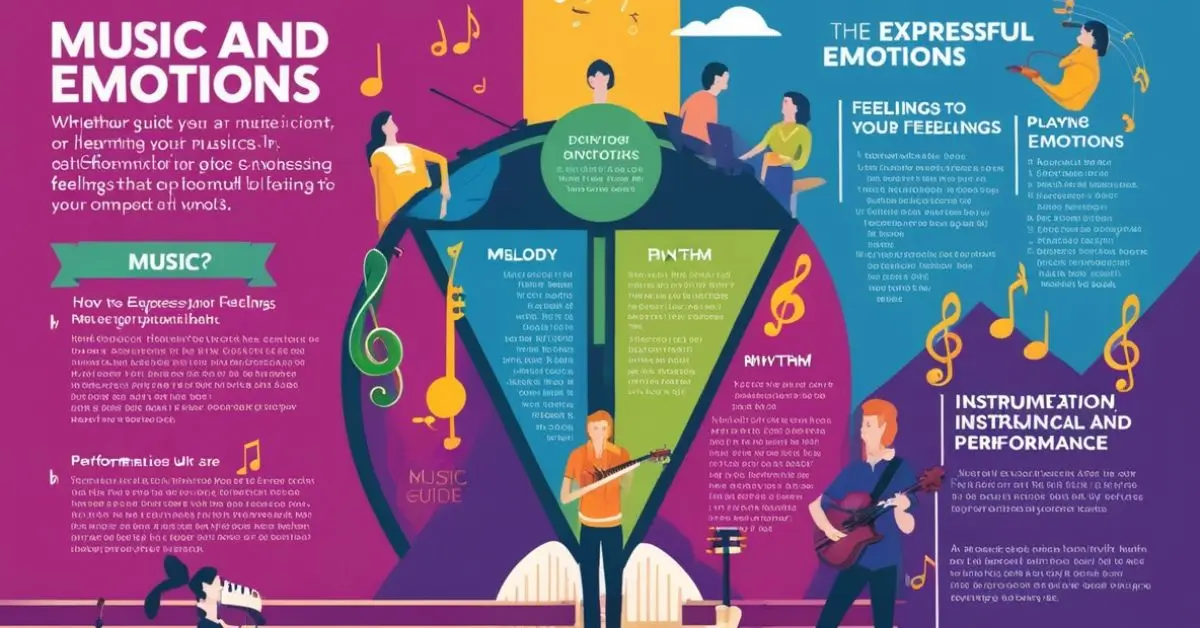How to Express Your Feelings in Music. Music is a powerful tool for expressing emotions, allowing people to communicate feelings that might be difficult to put into words. Whether you’re a musician, songwriter, or just someone who enjoys playing an instrument, learning to channel emotions into music can deepen both your personal connection to your art and the impact it has on others.
In this guide, we’ll explore the various ways you can express your feelings through music, including melody, harmony, rhythm, instrumentation, and performance. By the end, you’ll have a clear understanding of how to use music as an emotional outlet.
1. Why Music is the Ultimate Emotional Language
Unlike spoken language, music has a unique way of conveying emotions that transcend cultural and linguistic barriers. A single melody or chord progression can evoke joy, sadness, nostalgia, or excitement. The reason for this lies in the way our brains process sound.
Music triggers an emotional response by activating the limbic system, the part of the brain responsible for emotions and memory. That’s why certain songs can bring back vivid memories or make us feel a certain way almost instantly.
By understanding this connection, you can begin crafting music that authentically expresses what you’re feeling, whether it’s through instrumental compositions or lyrical storytelling.
2. Choosing the Right Musical Elements to Convey Emotion
Different aspects of music contribute to its emotional impact. Understanding how these elements work will help you make more intentional choices when composing or performing.
Melody and Emotion
Melody is often the most memorable part of a song, and its structure can influence how people perceive emotion in music.
- Ascending melodies tend to evoke feelings of hope, excitement, or triumph.
- Descending melodies can express sadness, longing, or melancholy.
- Repetitive melodies create a hypnotic, meditative effect, often associated with calmness or introspection.
- Unpredictable, dissonant melodies can convey tension, unease, or even fear.
Harmony and Emotional Color
Harmony adds depth to music and can drastically alter its emotional impact.
- Major chords are typically associated with happiness, warmth, and positivity.
- Minor chords often convey sadness, longing, or introspection.
- Dissonant chords create tension and unease, useful for evoking complex emotions.
- Open, sustained harmonies can create a dreamy, ethereal feeling.
Rhythm and Tempo
Rhythm dictates the movement and energy of a song, while tempo influences its overall mood.
- Fast tempos (120 BPM and above) create excitement, energy, and urgency.
- Moderate tempos (90-120 BPM) are often associated with confidence, relaxation, or groove.
- Slow tempos (below 90 BPM) evoke sadness, intimacy, or deep contemplation.
- Syncopation and offbeat rhythms add unpredictability, making a song feel more emotional and spontaneous.
Dynamics: The Power of Volume
The way music fluctuates in volume and intensity can create emotional highs and lows.
- Soft, quiet sections build intimacy and vulnerability.
- Loud, explosive moments create a sense of passion, power, or desperation.
- Gradual build-ups (crescendos) generate anticipation and emotional depth.
- Sudden drops in volume (decrescendos) can convey loss, reflection, or uncertainty.
3. Expressing Emotion Through Instruments and Sound Choice
The instruments you choose play a vital role in setting the emotional tone of your music.
- Piano – Extremely versatile; can be soft and delicate or intense and dramatic.
- Guitar – Acoustic guitars often feel warm and intimate, while electric guitars can be powerful and expressive.
- Strings (violin, cello, etc.) – Excellent for evoking deep emotions like sadness, nostalgia, or romance.
- Drums and Percussion – Can add energy, tension, or excitement.
- Brass (trumpet, saxophone, etc.) – Often associated with confidence, boldness, or celebration.
- Synthesizers and Electronic Sounds – Can create futuristic, dreamy, or eerie atmospheres.
By experimenting with different instruments and sound textures, you can amplify the emotions you want to express.
4. Using Lyrics and Storytelling to Convey Emotion
If your music includes lyrics, the words you choose are just as important as the melody and chords. Writing emotionally powerful lyrics requires honesty and vulnerability.
Tips for Writing Emotionally Expressive Lyrics:
- Write from personal experience – Draw from your own emotions and life events. Authenticity makes lyrics more relatable.
- Use vivid imagery – Instead of saying “I’m sad,” describe what sadness feels like in a metaphor or story.
- Keep it simple – Sometimes, the simplest lines carry the most weight. Avoid overcomplicating your message.
- Use repetition – Repeating a key phrase or chorus can reinforce the emotional impact.
- Experiment with perspective – Try writing from different viewpoints to explore emotions in new ways.
A great example of emotional lyricism is found in many blues songs, where simple, heartfelt phrases capture deep emotions with very few words.
5. How Performance Affects Emotional Expression
The way you perform a song greatly influences how its emotions are perceived. Even the most beautifully written piece can feel empty without the right performance.
Techniques for Emotionally Engaging Performance:
- Facial expressions and body language – Let your emotions show in your gestures and expressions.
- Vocal dynamics – Varying your vocal tone and intensity can make lyrics more impactful.
- Instrumental expression – The way you play an instrument (soft vs. aggressive, smooth vs. percussive) shapes the emotional delivery.
- Silence and pauses – Strategic moments of silence can enhance emotional depth and anticipation.
Some of the most memorable musical performances are those where artists fully immerse themselves in their emotions, drawing the audience into their world.
6. Emotional Expression in Different Musical Genres
Different genres lend themselves to different types of emotional expression. Choosing the right style can help you better communicate your feelings.
| Genre | Common Emotional Themes |
|---|---|
| Classical | Deep introspection, melancholy, or grandeur |
| Blues | Heartache, struggle, resilience |
| Rock | Rebellion, passion, intensity |
| Pop | Love, optimism, personal growth |
| Hip-Hop | Confidence, storytelling, empowerment |
| Jazz | Spontaneity, nostalgia, smooth emotions |
| Electronic | Euphoria, melancholy, dreamlike states |
Exploring different genres can help you find the best way to express your unique emotional landscape.
7. Practical Exercises to Improve Emotional Expression in Music
Here are some hands-on exercises to help you develop a stronger emotional connection to your music:
- Improvisation: Play an instrument without a plan and let your emotions guide the music.
- Emotional Mapping: Before composing, write down the emotions you want to express and brainstorm musical elements to match.
- Cover Songs with a Twist: Take a happy song and play it in a sad way, or vice versa, to explore emotional contrast.
- Freewriting Lyrics: Spend five minutes writing down raw emotions without editing, then shape them into lyrics.
- Visualization: Imagine a scene that matches the emotion you want to express and try to translate it into music.
8. Conclusion: Embrace Vulnerability in Your Music
Expressing your feelings through music is a deeply personal and rewarding process. The key to success is to embrace your emotions honestly and find the right musical elements to convey them.
Whether through melody, harmony, rhythm, lyrics, or performance, music gives you a limitless way to communicate your heart’s deepest feelings. The more you practice and experiment, the more naturally emotional expression will come through in your music.
If you’re interested in seeing real-world examples, check out this video on How to Express More Emotion Through Music: [YouTube Link Here]
Start experimenting today, and let your emotions shape the music you create.












